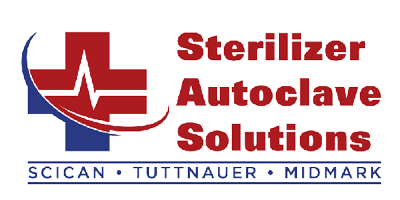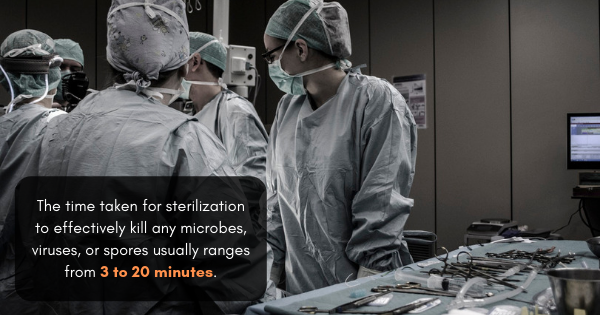How Do Autoclaves Work? Leave a comment
Did you know that sterilization machines, like autoclaves, must be regularly tested and serviced? According to the CDC, a spore test must be performed on each sterilizer at least once weekly.
Whether you’re looking for new or refurbished autoclaves for sale, or if you have one already that you want to learn how to use, this article will give you the basics on how to operate Tuttnauer autoclaves for sale to sterilize your equipment. Using an autoclave will allow you to kill harmful bacteria that would survive ordinary methods of cleaning. And if you just want to talk to someone, call our Free Tech Support at 704-966-1650 Option 3.
Why Sterilization Matters
So what exactly is sterilization, and why does it matter to such a broad range of industries, from hospitals to tattoo parlors?
Sterilization involves removing all microbes, viruses, and spores that could be living on a piece of equipment, from coming into contact with potentially hazardous materials. This prevents further contamination from occurring as the equipment is used again.
Medical equipment is so expensive that, in hospitals, sterilization is the only cost-effective method of preventing contamination of hazardous, microscopic substances and life forms.
In research experiment facilities, it’s absolutely essential to thoroughly sterilize all equipment, glassware, and even plasticware used in an experiment, in order for the experiments to be conducted safely and successfully.
In tattoo parlors, equipment must be sterilized between clients in order to prevent potential contamination and infections in clients.
One of the most common ways to sterilize equipment is with Tuttnauer autoclaves for sale.
What an Autoclave Is
Autoclaving involves using pressurized steam at very high temperatures, which kills microbes, viruses, or spores, which are difficult to kill or remove with conventional cleaning and disinfecting methods.
Depending on its location and function, Tuttnauer autoclaves for sale can be as little as a crock pot or as big as a commercial refrigerator.
In autoclaves, pressurized steam serves as the sterilization agent. Basically, the concept of an autoclave is to have objects needing sterilization come into direct contact with the pressurized steam, at particular pressures and temperatures and for particular periods of time, in order to kill any lingering bacteria.
The four pillars that allow an autoclave to function—and which must be managed correctly to be effective, and differently depending on the object being sterilized—are steam, temperature, pressure, and time.
The period of time and the necessary temperature depend on the kind of material that’s being autoclaved. If you use higher temperatures, you don’t need to have the equipment inside the autoclave for as long.
The most common temperature settings for sterilization are 121C and 132C. To reach such high temperatures, the steam must be pumped into the sterilization chamber at a pressure exceeding normal atmospheric air pressure.
How an Autoclave Works
There are lots of different kinds of items which can be sterilized, from previously used medical equipment to liquid being used in a research experiment.
To begin the sterilization process, the object is placed inside the autoclave chamber. The chamber is then sealed shut. As mentioned previously, the steam used by autoclaves is compressed inside the chamber, at a pressure exceeding normal atmospheric air pressure. For this to be possible, first the air inside the chamber must be removed. Depending on the autoclave’s design, this step can be different for everybody.
The two most common designs of Tuttnauer autoclaves for sale are high-speed pre-vacuum sterilizer and gravity displacement sterilizer. The gravity displacement sterilizer uses a drain vent to force air out, which is accomplished by forcing steam in through an opening in the top or side. The high-speed pre-vacuum sterilizer has a vacuum attached (as its name implies), which forcefully removes the air inside, thus allowing steam to fill the chamber.
Although the method for air removal differs, the end result for both of these designs is the same: air is removed from the chamber, which allows steam to come in.
As the steam is pumped into the chamber, it’s forced to enter the autoclave at a pressure exceeding atmospheric pressure. Because of this increase in pressure, the steam is able to reach temperatures far higher than steam normally could, usually between 121 C and 140 C.
The amount of pressurized steam pumped into the chamber depends upon the necessary temperature required for complete sterilization. The time taken for sterilization to effectively kill any microbes, viruses, or spores usually ranges from three to 20 minutes, and depends upon the type of material being sterilized.
As always if you have any questions about this process or anything else please feel free to contact us and take advantage of our “FREE TECH SUPPORT.”
We also offer FREE VIRTUAL TECH SUPPORT to “See and Talk” with a “Real Time Live Technician” for any problems you may be in need of help with.
You can also use our “FREE MAINTENANCE PROGRAM”. Take the guesswork and worrying about what unit is due for maintenance and which maintenance cycle it is time for. We will keep track of all your autoclaves and let you know when it’s time for anything.


